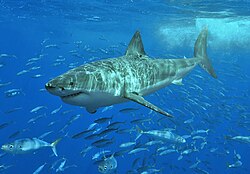| Mackerel sharks Temporal range: [1] | |
|---|---|
 | |
| Great white shark Carcharodon carcharias | |
| Scientific classification | |
| Kingdom: | Animalia |
| Phylum: | Chordata |
| Class: | Chondrichthyes |
| Subclass: | Elasmobranchii |
| Division: | Selachii |
| Order: | Lamniformes |
| Family: | Lamnidae J. P. Müller and Henle, 1838 |
| Extant genera | |
| |
The Lamnidae are the family of mackerel sharks known as white sharks. [2] They are large, fast-swimming predatory fish found in oceans worldwide, though they prefer environments with colder water. The name of the family is formed from the Greek word lamna, which means "fish of prey", and was derived from the Greek legendary creature, the Lamia. [3]
Contents
These sharks have pointed snouts, spindle-shaped bodies, and large gill openings. The first dorsal fin is large, high, stiff and angular or somewhat rounded. The second dorsal and anal fins are minute. The caudal peduncle has a couple of less distinct keels. The teeth are gigantic. The fifth gill opening is in front of the pectoral fin and spiracles are sometimes absent. They are powerful, heavily built sharks, sometimes weighing nearly twice as much as other sharks of comparable length from other families. Many sharks in the family are among the fastest-swimming fish, although the massive great white shark is slower due to its large size.